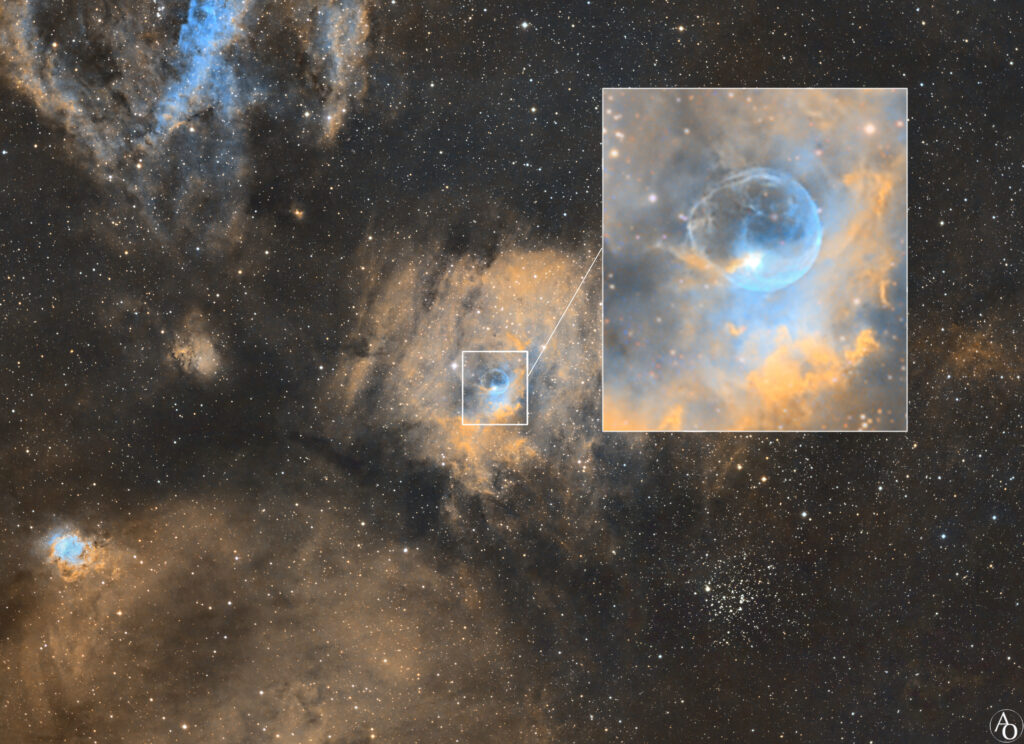NGC 7635 is an emission nebula, an H II region, in the constellation Cassiopeia, near the open cluster M52. It has originated from the stellar wind of the central star SAO 20575 (BD+60 2522), of apparent magnitude 8.7. Due to its shape, it is also called the Bubble Nebula.
The sublime beauty of the Bubble Nebula is not only manifested in the plane of aesthetics but inside it keeps surprising components.
The markedly spherical bubble shape of NGC 7635 signals the boundary between the strong particle wind coming from inside the star as it collides with the surrounding dense material. The central star has between 10 and 20 times the solar mass and is responsible for the winds of 2000 km/s.
The bubble is not uniform because when expanding it finds regions of cold gas of different density that slow down the expansion, which gives it an undulating appearance. These differences in the material found by the wind is what has caused the star not to focus in the center.

Technical data:
Telescope: S/C 8″
CCD:Atik314L+
Focal Length Reducer: Meade 6.3
Filters: Ha 12nm/O[III] 12nm/S[II] 12nm
Telescope Guide: SkyWatcher ED80
Mounth: LX200 GPSR
Guide CCD: QHY5
CCD Temp:-5º
Ambient Temp:0º
Location: Anunaki Observatory / Rivas Vaciamadrid (Madrid)
Images obtained with the Hubble Space Telescope allow us to observe to the right of the star a denser crest of gas. The lower area of this ridge is closer to the star and is therefore brighter. It suffers ultraviolet radiation with greater intensity, and together with the strong wind, it experiences a more intense photo-evaporation.
There is no unanimity as to the distance at which NGC 7635 is located. While some sources place it 7,100 light years from the Solar System, others indicate a greater distance, around 11,000 light years.
Technically called NGC 7635, this nebula has a diameter of ten light-years and is located 11,000 light-years from Earth.
The center of the nebula is inhabited by a hot, O-type star whose brightness is at least 100,000 times that of our Sun, which it also exceeds in size, being approximately 45 times greater. The stellar wind and the intense radiation emanating from this star are responsible for having molded the luminous gas structure into a kind of gigantic molecular cloud.
Here is the last image obtained from NGC 7635, in Ha,O[III] and S[II] narrowband filters, with 18 hours of integration. In modified Hubble palette.

This image was awarded on 11/07/2023 by AAPOD, a work very well rewarded. You can find it in the archives of https://www.aapod2.com/blog/ngc-7635
Technical data of the acquisition:
Baader H-alpha 6.5nm (CMOS-Optimized) 36 mm: 24×900,″(6h)
Baader O-III 6.5nm (CMOS-Optimized) 36 mm: 24×900,″(6h)
Baader S-II 6.5nm (CMOS-Optimized) 36 mm: 24×900,″(6h)
Time integration:
18h
Taking advantage of images from 2014 that I had taken with a 203mm S/C and an ATIK 314L+ ccd, which can be seen in the first photo of this post. I have decided to add them to the recently acquired images to give resolution to the center of the bubble and surroundings.
Although the processing techniques have been complicated, it seems that combining different resolutions has a very positive effect on astronomical images.

